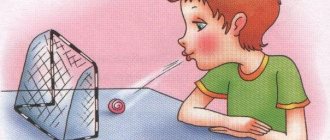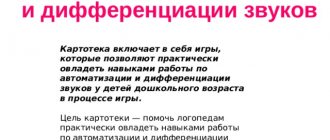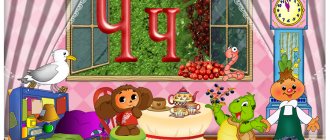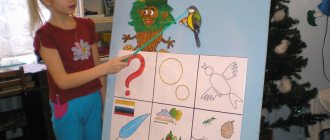Automation of sounds L in game exercises, Album of a preschooler, Komarova L.A., 2008
Automation of the sounds L in game exercises, Album of a preschooler, Komarova L.A., 2008. The manual offers a system of exercises for automating the sounds L in preschoolers 4-7 years old, which turns the monotonous and monotonous work of consolidating the pronunciation of sounds into an interesting game. Along with their automation, the child’s reading skills improve, fine motor skills and creative imagination develop. Automation of the sounds Ch, Shch is carried out according to the traditional scheme in speech therapy. The effectiveness of correctional work is ensured by the use of a number of auxiliary techniques (working with three-dimensional and flat toys, counting sticks, creating game situations in class). The manual is intended for individual work with a child and is addressed to speech therapists, teachers of speech therapy groups and parents of children with speech disorders. ARTICULATIVE GYMNASTICS. All exercises are performed in front of a mirror. Exercises 1-3 involve holding a static pose for a count of up to 5 (up to 10); Exercises 4-6 are performed 10-15 times. 1. FENCE Smile (teeth closed and visible). Keep your lips in this position. 2. SPATULA Open your mouth. Place a wide, relaxed tongue on your lower lip. Place the “spatula” in your mouth. trying not to strain my tongue. 3. NEEDLE Make the tongue narrow (tighten). Push the narrow tongue far forward and then remove it deep into the mouth. Open your mouth slightly. 4. TASTY JAM Open your mouth. Use a wide tongue to lick your upper lip, making movements from top to bottom. The lower jaw is motionless!
Download the e-book for free in a convenient format, watch and read: - fileskachat.com, fast and free download.
Below you can buy this book at the best price with a discount with delivery throughout Russia. Buy this book
How to open a file
Copyright holders
- djvu - Yandex.Disk.
Publication date: 05/31/2019 18:46 UTC
Russian language textbook :: Russian language :: Komarova
See also textbooks, books and educational materials:
- Speech practice, 1st grade, Komarova S.V., 2017
- Speech practice, 3rd grade, Komarova S.V., 2018
- Speech practice, 2nd grade, Komarova S.V., 2018
- Automation of sounds Ch, Shch in game exercises, Album of a preschooler, Komarova L.A., 2009
The following textbooks and books:
- Test book, thematic control of students’ knowledge, Russian language, grade 4, practical guide for elementary school, Golub V.T., 2017
- Copy 3, For children 6-7 years old, Zhukova N.S., 2011
- Propis 2, For children 6-7 years old, Zhukova N.S., 2011
- Copy 1, For children 6-7 years old, Zhukova N.S., 2011
Previous articles:
- Russian language without errors, Quick methodology for improving literacy, Shestov M., Proskura O., 2018
- Culture of Russian business speech and business rhetoric, Rodina I.V., Promakh L.V., 2018
- Russian language, Syntax, Punctuation, Textbook and workshop for SPO, Lobacheva N.A., 2019
- Russian language in business documentation, Textbook and workshop for SPO, Ivanova A.Yu., 2019
<< Previous articleNext article >>
LiveInternetLiveInternet
Quote from Jolochka's message
Read in full In your quotation book or community!
Komarova.
Automation of sound C in game exercises. Preschooler's Album INTRODUCTION
A system of exercises for automating the sound “C” is offered to the attention of speech therapists and parents.
The material presented in this manual turns the monotonous and monotonous work of strengthening the pronunciation of sounds into an interesting game. Simultaneously with the automation of sound, the child’s reading skills improve, fine motor skills and creative imagination develop. Working on this manual contributes to faster automation of sound in spontaneous speech; development of phonemic hearing, improvement of the syllabic structure of a word, correction of the lexical-grammatical structure of speech, consolidation of knowledge about the automated sound and the corresponding letter, formation of the skill of sound-letter analysis of syllables and words. At the same time, fine motor skills of the fingers develop; activation of memory, attention, thinking. All this, in turn, is a timely prevention of dysgraphia and dyslexia. Depending on the complexity of the child’s speech defect and the stage of correctional work, games and tasks can be used in combination by the speech therapist. Automation of the sound “C” is carried out according to the traditional scheme in speech therapy. First, a set of articulatory gymnastics exercises is performed. Then exercises are offered to automate the sound “C” in isolation, based on the material of syllables, words, sentences, poetic and prose texts. In order to make the process of automating sounds in words more fun and effective, a number of auxiliary techniques are proposed. One of them is the use of small volumetric (for example, from Kinder surprises) or flat* toys , the names of which contain an automated sound (owl, dog, elephant, etc.). This technique also helps to activate the child’s attention and maximally supports his interest in the material being studied throughout the lesson, bringing the joy of self-expression and, of course, causing positive emotions. The game situation creates a relaxed atmosphere in the lesson, frees the child from constraint, encourages him to communicate, and promotes quick contact with the speech therapist. Work with the toy is carried out during the following games:
- Labyrinth.
The child, clearly pronouncing the sound being studied, names the pictures presented on each page of the album in a given order, moving the selected toy along the arrows. Movement starts from the cell marked with an asterisk. If a child names a word incorrectly, then the next move cannot be made until the word is named correctly. - ^ Labyrinth with pronunciation.
When moving through a maze, a child must not only name the pictures, but also indicate the direction of the next move. For example, an airplane goes to the right, a nightingale goes up, etc..” - Maze with skipping a turn.
The game is played in two stages. First, the child names all the pictures in order, and then, starting with the picture marked with an asterisk, one after another. - ^ Labyrinth in reverse.
First, the child pronounces all the words - the names of the pictures in the maze. Then he places the toy on the last picture of the maze and moves in the opposite direction, calling out the words.
It is recommended to play these games with each labyrinth (pp. 5-13). If, while going through the maze, the toy lands on a square with a question mark, the child must come up with a word with an automated sound in a certain position. Subsequently, the pronunciation of the sound is consolidated in phrases, sentences, stories and poetic texts. Be patient and kind. Then the results of working with your child will definitely please you! 1 Shown on the back cover. ^ ARTICULATIVE GYMNASTICS
All exercises are performed in front of a mirror. Exercises 1-3 involve holding a static pose while counting up to 5 (up to 10); Exercises 4-12 are performed 10-15 times.
2. FENCE
1. SMILE
Smile (teeth visible).
Keep your lips in this position. Keep your lips stretched out in a smile. The teeth are not visible. 4. PUNISH A DISOBEDIENT TONGUE
3.
CHILDREN
Open your mouth slightly, calmly put your tongue on your lower lip and, spanking it with your lips, say “five-five-five...” Open your mouth wide, spreading the corners of your lips as far apart as possible.
The tongue lies in the mouth calmly and motionless. 6. TUBE 5. SPATULA
Open your mouth, stick out your wide tongue and bend its side edges up.
Blow into the “tube”. You can hold the “tube” from the tongue with your lips. Place a wide, relaxed tongue on your lower lip. Place the “spatula” in your mouth, trying not to strain your tongue ^ 7. LICK YOUR SPONGS 8. BRUSH YOUR TEETH First with your mouth closed, then with your mouth open
Open your mouth.
Slowly, without lifting your tongue, lick first the upper, then the lower lip in a circle. “Brush” the lower teeth from the inside with the tip of your tongue (from left to right, from top to bottom). The lower jaw is motionless. 10. SNAKE 9. WATCH
Stretch your lips into a smile.
Open your mouth slightly. Using the tip of your narrow tongue, alternately touch the corners of your mouth. Open your mouth. Push the narrow tongue forward and put it back into the mouth. Do not touch lips and teeth. 12. PUSH THE BALL INTO THE GOAL 11.
CANDY Close your mouth, press your tense tongue first on one cheek, then on the other.
Place your wide tongue on your lower lip and smoothly, with an F sound, blow out a cotton ball lying on the table between two cubes. The cheeks should not puff out. Exercise “Cold Breeze”.
Help the snowflakes reach the Snow Maiden. Run your finger along the path, pronouncing clearly: S-S-S... When pronouncing the sound “S”, the breeze should be cold so that the snowflakes do not melt (raise your palm to your mouth and check).
^ Exercise “Songs of Magpies”.
Magpie teaches everyone in the forest to pronounce the sound “S” correctly. For this she came up with an interesting game. Let's play with her. Repeat the magpie song syllables. Try not to make mistakes. Pronounce the “S” sound clearly.
Labyrinth 1
Exercise “Echo”*.
Listen to the words.
(The speech therapist calls any 2-5 words - names of pictures.)
Remember them and repeat them in the same order with the toy, emphasizing the sound “C”.
^ Exercise “Living - Nonliving”*.
First, name the words denoting living objects, and then - inanimate objects.
Exercise "Guess".
I will name an action word, and you select the corresponding object word for it and say the entire phrase.
Sample: There goes... (dog).
*Hereinafter: games marked with an asterisk can be played with any maze.
List of pictures of the labyrinth: owl, scoop, dog, magpie, barn, sugar, scooter, plane, boots.
Labyrinth 2
Exercise “What’s missing?”* Look at the pictures and remember them.
I will cover one picture with a magic screen, and you look and tell me what is missing (the game is repeated several times).
Exercise "Riddles".
I will tell you the words-signs, and you show the corresponding picture and name the word. ^ Sample: sharp..
-
braid.
List of pictures of the labyrinth: wasp, scythe, fox, cash register, meat, mustache, beads, braids, scales.
Exercise “Photographer”*. Using the magic camera, “photograph” (memorize) as many pictures as possible. Close the album and name the “photographed” pictures. Labyrinth 3
Exercise “Visiting the Dwarves.”
I'll name the big object, and you name the small one.
^ Sample: catfish - catfish.
What words cannot be changed?
Exercise “Come up with it yourself.”
Listen to my questions.
Choose as many answers as possible. Sample: What kind of bag?
- The bag is small, beautiful, blue... List of pictures of the maze: catfish, juice, salt, pacifier, pine trees,
,
sled, saber, bag
Exercise “Make a sentence”*.
Choose any picture word and make a sentence with it.
Imagine that there are a lot of these objects. How will your offer change? Sample: Juice is on the table. Juices are on the table. Maze 4 Exercise “Clapperboards”*.
Following the labyrinth, name the pictures syllable by syllable, determining their number by clapping.
Then I will think of a word, clap it syllable by syllable, and you guess the word. ^ Exercise “Say the Word”*.
I will say the beginning of a sentence, and you choose the appropriate picture word and complete it.
Sample: Sonya eats delicious... (pineapple).
List of pictures of the labyrinth: nose, forest, cactus, ficus, globe, bus,
,
pineapple, compass
Exercise “Halves”*.
Listen to the syllable - the beginning (end) of the word.
Look at the pictures. Find the corresponding picture, name the missing syllable and the whole word. Sample: car... -bus, bus; ...pass - com-, compass. Maze 5 Exercise “Change the order of words in a sentence.”
Come up with a sentence of two (three) words from each of the pictures.
Change the order of the words and say a new sentence. (The exercise is performed based on the diagram.) For example: Oats grow in a field.
—
Oats are growing in the field.
List of pictures of the maze: oats, tray, coconut, pump, apricot, vacuum cleaner,
,
belt, compass
Exercise “Find Me”*.
Look at the sound diagram and find the word I thought of.
(The speech therapist lays out the sound diagram of the selected word with colored chips, and the child conducts a sound analysis and finds the corresponding word.) Labyrinth 6 Exercise “Magic Wand”*.
Touching each picture with a magic wand, change their names according to the example.
^ Sample: donkey - donkeys.
What words haven't changed?
Touching each picture with a magic wand, change their names according to the example. Example: donkey - donkey.
What words haven't changed?
^ Exercise “My, my, mine”*.
Name only those pictures about which you can say
mine (mine, mine).
Make up phrases based on the example.
Sample: my helmet...
List of pictures of the maze: donkey, socks, board, helmet, mask,
,
paints, stroller, <word diagram>
Exercise “Match the words to the diagram.”
Look at the sound pattern in the last cell of the maze.
Which pictures fit this diagram? ^ Exercise “The fourth is extra.”
Help Little Thumb.
Find the extra picture in each row and circle it. Explain your choice. Repeat the names of all the extra pictures, clearly pronouncing the sound “C”. Exercise "Count."
Count all the pictures according to the sample.
Sample: one cactus, two cacti...
Which objects are there more?
Which ones are less? Count the items in reverse order according to the pattern. Sample: five cacti, four cacti... ^ Exercise "Guess".
Listen to the action word. Match it with pictures that have a corresponding meaning using a pencil of the appropriate color. Say the resulting phrases, emphasizing the “C” sound.
^ SHINES
FLYING STANDING GOING Exercise “Whose traces?”
Name the pictures, emphasizing the “S” sound.
Connect each animal and its tracks with lines of different colors. Make up a phrase based on the example. Sample: elephant tracks. ^ Exercise “Collect pictures”.
The evil sorceress Bastinda bewitched the pictures.
Look at them. Name whose head and tail each resulting animal has. Unenchant the pictures. Draw a line from each animal's head to its tail. Sample: Dog tail, dog head.
^ Exercise “Add words”.
Listen to a few words.
Put them together to make new words. Example: an airplane flies on its own.
Name new words, pronouncing the sound “S” clearly, and show the corresponding pictures.
Then name each picture and remember the two words that make up its name. COOKING ROLLING FALLS CHOPPING FALLING FLYING LEG HORN ITSELF SNOW FOREST LEAVES FORTY nose ^ Exercise “New Year's gifts.”
Name the heroes of fairy tales who came to the New Year holiday.
Draw pencils of different colors along the path lines, and you will find out what gifts Grandfather Frost left for the heroes under the tree. Make up sentences based on the model. Sample: Grandfather Frost gave Sadko a globe.
Little Fox... ^ Exercise “Say the opposite.”
Listen to the suggestions. Add a suitable word with the sound “S” to each sentence. Repeat the entire sentences, emphasizing the “S” sound. A couple of pictures will help you cope with the task.
The onion is bitter, and the apricot is... (sweet)
Dad is young, and grandfather is ...
(old)
The lion is strong, and the lamb is ...
(weak)
The fly agaric is inedible, and the boletus is ...
(edible)
The notebook is thin, and the book is ...
thick)
It is dark at night, and during the day - ...
(light)
The red pencil is dull, and the blue one is ...
(sharp)
^ Exercise “Small words”.
Look at the pictures. Name the objects depicted and tell where they are. Answer the questions in complete sentences. What little words did you use?
Where does the owl sit? (The owl sits in a hollow.)
Where do bullfinches fly?
(Bullfinches fly over the snowman.)
Where is the dog?
(The dog is in front of the pine tree. The dog is between the sled and the bench.)
Where is the snowman?
(The snowman stands behind the bench. The snowman stands near the pine tree.)
Where is the sled?
(The sled is standing in front of the dog.)
Where do plum trees grow?
(Plums grow on a tree.)
Where is Sonya sitting?
(Sonya is sitting on the bench.)
Where is the baby sitting?
(The baby is sitting in the stroller.)
Where is the stroller?
(The stroller is in front of the bench.)
Where does the dog sleep?
(The dog is sleeping under the bench.) Exercise “Make a sentence.”
Make up sentences about Sana and Sonya using diagrams based on pictures.
^ Sample: Sanya... mask.
— Sanya put on a mask. ^ Exercise “Fold the picture.”
Listen to the poems and learn them by heart. Use counting sticks (matches) to make pictures according to the pattern. Remember and repeat each poem.
Snow
Sonya, look out the window!
How much snow there was! Both in the forest and in the Pine garden, everyone ate in the snow! ^ M. Fomicheva
What words with the sound “S” do you remember from this poem?
Sleigh
Little Sanya was given a sleigh, Look for yourself, what a sleigh!
S. Kogan
Make up a sentence with the word
sleigh. ^ Exercise “Fold the picture.”
Listen to the poems and learn them by heart.
Use counting sticks (matches) to make pictures according to the pattern. Remember and repeat each poem. Pussy and bowl
Pussy eats soup from a bowl.
The pussy is full, the bowl is empty. Call your cat affectionately with words that contain the sound “S”. For example: kitty, kisulya, pussy. Airplane
We’ll build the airplane ourselves, Let’s fly over the forests.
Let's fly over the forests, and then we'll return to mom. A. Barto
What words with the sound “S” do you remember from this poem?
^ Exercise “Riddles”.
Listen and guess the riddles.
The pictures will help you cope with the task. Learn the riddles by heart. He is fluffy, furry, planted a seed, silvery, mustachioed, raised a sun, white, white, eats and drinks, (Sunflower)
clean, clean.
(Snow)
Sings songs.
^ G. Boyko (Pussy)
They go, they go, A hundred clothes What grows upside down? And they won’t budge. and all without fasteners. (Icicle)
(Clock) (Cabbage) Exercise “Describe the toy.”
Sonya was given a toy - a plastic elephant.
Her friend Sveta called her and started asking about the gift. Help Sonya answer the questions. *
- What color is the elephant?
(The elephant is gray.)
- What is the size of an elephant? (The elephant is big.)
- Name the parts of an elephant's body? (An elephant has a head, large ears, a nose, a trunk, a torso, 4 legs, a tail.)
- What is the elephant made of, what material? (The elephant is made of plastic.)
- What is the elephant wearing? (The elephant is dressed in blue overalls, striped boots, and a red sweater.)
- What can an elephant do when performing in a circus? (The elephant can ride a bicycle.)
Repeat the whole story from the beginning.
^ Exercise “Tell me.”
Listen to the story.
Retell it, trying to convey the intonation of the characters in your voice. How do you think this story ends? Come up with a continuation of the story (make 3-5 sentences). Name words with the “S” sound. ^ MAGIE AND THE BEAR
- Hey Bear, answer the question!
- What question, chirp?
- Why do they call you Bear? Capercaillie - he is deaf in the spring, of course. The white hare is white in winter, of course. But the Bear is unclear.
- Ha ha ha! You stupid bird. Bear. That means he knows the honey. I know where the honey is hidden in the forest.
- And where, where is it, honey?
- That's what I told you! You'll tell everyone right away. Then all of you will become bears in the forest...
Exercise “Correct the sentence.”
Listen to the proposals that Slava came up with. Find mistakes and fix them.
Sonya eats soup. A pine tree sits on an owl. Sanya put the boots on. There was snow on the tracks. ^ A piece of meat bites a dog. The table was set on the dishes.
There is a bridge behind the forest. Sonya wears beads. The table was laid on a tablecloth. The asters planted the gardener.
^ Exercise “Retelling with pictures.”
Repeat each sentence, replacing the pictures with the corresponding words. Retell each story from the beginning. Give each story a title.
Sonya looked out
the snow was falling outside the window. Stas was riding . And Sveta was sitting under , sculpting him . The guys had fun. Sonya took it out and began to draw. ^ One day, dad and son decided to cook dinner. They made a salad from and made soup from . They prepared hodgepodge with juice from . We baked a cupcake with . They covered it and called mom. What a delicious lunch it turned out to be! ^ Exercise “Fun Train”*.
Help passengers travel on a fun train.
Name each passenger, emphasizing the “S” sound. Clap your hands for the number of syllables in each word, and you will find out who will ride in which carriage (the number of syllables in a word coincides with the number of windows in the carriage). Draw a line-path from each passenger to his trailer. * Starting with this activity, children are offered literacy games.
^ Exercise “Find the word”.
Name the words, emphasizing the “S” sound. Find words in which the sound “S” is at the beginning (in the middle, at the end). Connect each picture with the corresponding diagram. Make up a sentence with each word - the name of the picture. Come up with your own examples of words for each diagram.
с
С с ^ Exercise “Make a sound diagram”.
Using colored pencils, color in the sound pattern of each word. Indicate hard consonant sounds in blue, soft consonant sounds in green, and vowel sounds in red. Name words whose patterns are the same.
SA
SU
CO
^ Exercise “Match words into syllables.”
Read the syllables.
Find and name suitable pictures for each syllable. The arrows will help you. The number of arrows that come from a syllable equals the number of pictures for that syllable. Think of more words for each syllable. Sample: co - juices.
Exercise "Magic track".
Help Puss in Boots get to the castle.
To do this, read the syllables and words on the stones of the path. ^ Exercise “The Word Scattered.”
Look at the pictures. In the empty cells, write down their names from scattered letters.
y to So
syu o s SaK I s A L ^ Exercise “Collect a word.”
Complete the tasks of the Scientific Owl, and you will find out what words she wished for. Write the resulting words in the empty cells. Make up 2-3 sentences with each word. The first move is the letter marked The first move is the letter marked with a red asterisk. green star. The second move is two cells up. The second move is two cells to the left. The third move is four cells to the left. The third move is one cell up. The fourth move is two cells down. The fourth move is one cell to the left. The fifth move is two cells down. The fifth move is one cell down.
^ Exercise “Decipher the words.”
Help Kai solve the riddles of the Snow Queen. Make words from the first letters of the words-names of the pictures and write them down.
Exercise "Staircase".
Look at and name the pictures. Count the number of sounds in each word and write the words in the corresponding cells of the “ladder” crossword puzzle.
BBK 74.3 K63 ^ Publication of developmental education for preschool children Recommended by the Academic Council of the Pedagogical Society of Russia
Komarova L.A.
K63 Automation of sound C in game exercises. Preschooler's album / L.A. Komarova. -M.: Publishing house GNOM and D, 2007. - 32 p. 15ВМ 978-5-296-00784-1 The manual proposes a system of exercises for automating the sound “C” for preschoolers aged 4-7 years, which turns the monotonous and monotonous work of consolidating the pronunciation of the sound “C” into an interesting game. Along with its automation, the child’s reading skills improve, fine motor skills and creative imagination develop. Automation of the sound “C” is carried out according to the traditional scheme in speech therapy. The effectiveness of correctional work is ensured by the use of a number of auxiliary techniques (working with three-dimensional and flat toys, counting sticks, creating game situations in class). The manual is intended for individual work with a child and is addressed to speech therapists, teachers of speech therapy groups and parents of children with speech disorders. BBK 74.3 Publisher - ^ A.P.
Kazakov Editor -
N.E.
Ilyakova Illustrations -
D. R. Kudryakov, N.V.
Kulakova Cover -
D.R. Kudryakov
Original layout -
N.M.
Kudryakova LLC Publishing House GNOM and D Tel./fax. E-ta'I: dpot_1odorea'@pe\l/ta||.gi Sanitary-epidemiological conclusion No. 77.99.60.953.D.004022.04.07 dated 04/11/2007. Signed for publication on 06/02/2007. Offset printing. Volume - 2 p.l. Format 84x108/16. Circulation 10,000 copies. Order No. 2622. Printed by order of Social Project Agency LLC at Moscow Printing House No. 2 OJSC. 129085, Moscow, Prospekt Mira, 105. Tel., 682-54-05. © Komarova L.A., 2007 15Y 978-5-296-00784-1 © Design. LLC Publishing House GNOM and D, 2007
***********************************************************************************************************
*Flat toys for playing games with mazes.
The set includes toys: elephant, owl, dog, magic wand, magic camera, magic screen.
Before you start playing, the pictures must be cut out along the contour, folded along the dotted line and glued. For an elephant, an owl and a dog, you must first bend the white flaps-stands to the sides (to give the toys stability).
Series of messages “speech therapy”:
Part 1 - Speech therapy lotto. Learning sounds [P] - [P'] Part 2 - Demonstration material for classes with preschoolers. Speech therapy... Part 40 - Setting the sound P from lower vibration. Part 4 Part 41 - Producing the sound P by imitation. part 1 Part 42 - Komarova. Automation of sound C in game exercises. Album of a preschooler Part 43 - Exercises for conducting speech therapy classes with children (articulation gymnastics
Series of messages “speech development”:
Part 1 - SPEECH DEVELOPMENT. LEXICAL TOPIC “INSECTS”. Part 2 - SPEECH DEVELOPMENT. LEXICAL TOPIC "PROFESSIONS". ... Part 31 - Patterns of Olesya Emelyanova’s glove dolls. Part 32 - Mitten dolls. Puppet theater Part 33 - Komarova. Automation of sound C in game exercises. Album of a preschooler Part 34 - Exercises for conducting speech therapy classes with children (articulation gymnastics







